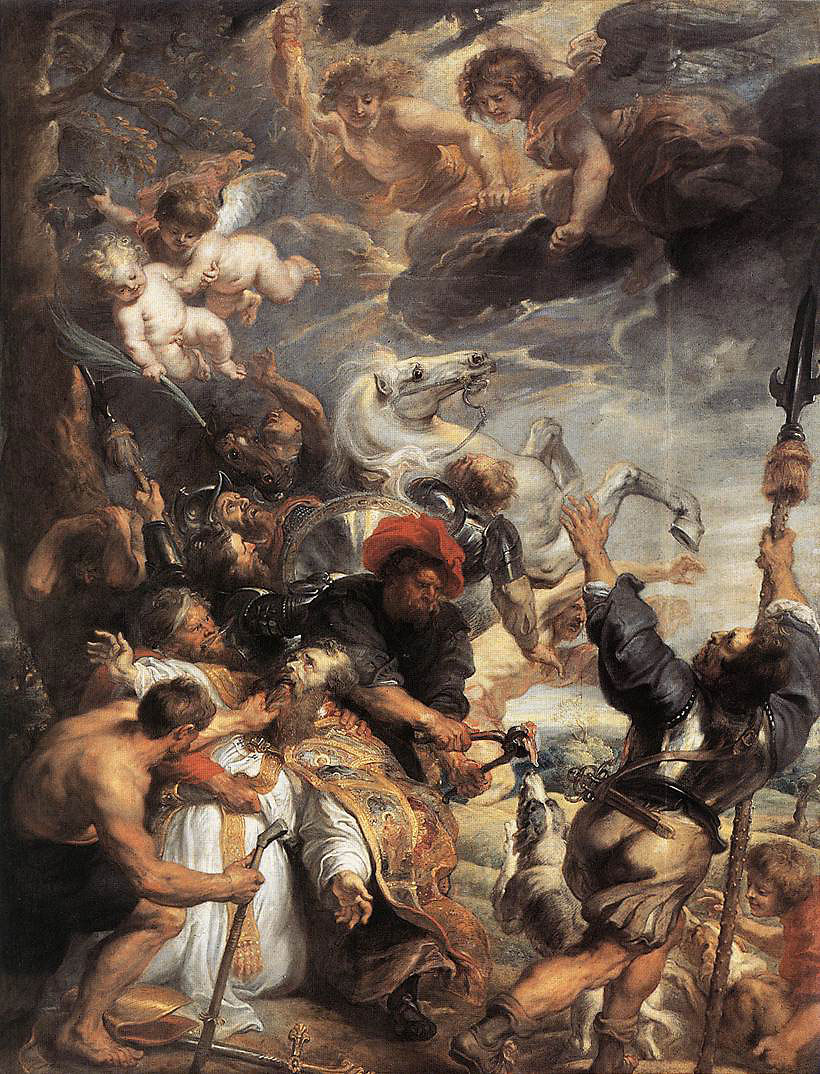Rubens, Le Martyre
de Saint Livinus, 1633, 455
X 347,
Bruxelles, Musées Royaux des Beaux-Arts
Saint Livin
Évêque
et martyr à Gand (✝ v. 657)
Lievin ou Lebuin.
Evêque irlandais et apôtre de la Flandre occidentale. Il évangélisa la région,
mais un jour qu'il prêchait aux habitants d'Esche, il fut assassiné par un
groupe de païens hostile à sa prédication. Il est l'un des patrons de la ville
de Gand, considéré comme un martyr.
November 12
St. Livin, Bishop and Martyr
THIS saint was a learned and zealous Irish bishop, who went over into
Flanders to preach the faith to the idolaters. To enter upon that work by
dedicating himself a holocaust to God, he spent thirty days in prayer at the
tomb of St. Bavo, at Ghent, and offered there every day the holy sacrifice.
After this solemn consecration of himself to his Redeemer, he began to announce
the word of life, and converted many about the country of Alost and Hautem.
Having cultivated the study of poetry in his youth, he composed an elegy on St.
Bavo, who died only six years before him. 1 St. Livin was massacred by the
pagans, at Esche, in the year 633, according to Colgan, who mentions him to
have been bishop of Dublin before he went to the mission of Flanders. His death
is placed by others in 656. He was buried at Hautem, three miles from Ghent;
and his relics were translated to the great monastery of St. Peter’s at Ghent,
in 1006. In a shrine by that of St. Livin are preserved the relics of St.
Craphaildes, a lady in whose house St. Livin was martyred. She was murdered by
the same barbarians, for lamenting his death, and her infant son Brictius, whom
St. Livin had lately baptized. The infant martyr’s bones are kept in the same
shrine with those of St. Livin. St. Brictius is commemorated in a collect with
other saints of this monastery. Usher 2 and Mabillon have also published a
letter of St. Livin, whose name occurs in the Roman Martyrology on this day.
See his life written by one Boniface in the same age, in Mabillon, Sæc. 2, Ben.
p. 251; Cointe, Annal. Fr. ad an. 651; Fleury, l. 38, n. 58; Miræus, in Fastis
Belg. Sanders, Rerum Gandav. l. 4, p. 342; and Colgan, Trias Thaum. p. 112, n.
69.
Note 1. This elegy it published by Usher, and Mabill. Sæc. 2 Ben. p. 461, and
read in the old office of St. Bavo, at Ghent, published by Gerard
Salenson. [back]
Rev.
Alban Butler (1711–73). Volume XI: November. The Lives of the Saints. 1866.
Livinus
of Alost BM (RM)
(also known as Lebwin)
Died c. 650. An Irishman by birth, he was ordained a priest by Saint Augustine
of Canterbury, and sailed to Flanders, where for some years he preached the
gospel with great success. At some time during this period he is said to have
been consecrated bishop in Ireland. He was martyred with several companions
near Alost, Brabant, Belgium. His relics are enshrined and venerated at Ghent.
He is perhaps to be identified with as Saint Lebuinus (Benedictines, Montague).
Saint Lebwin is shown as a bishop holding his tongue with a pair of tongs
(because it was plucked out). Venerated at Alost (Roeder).
San Livino (Lebuino) Vescovo
† Houtem (Belgio), 775 ca.
Martirologio Romano: A Deventer in Frisia, nell’odierna Olanda, san
Lebuino, sacerdote, che, monaco venuto dall’Inghilterra, si adoperò per
annunciare agli abitanti di questa regione la pace e la salvezza di Cristo.
Nonostante
le incertezze sulle notizie della vita, esistono di lui varie raffigurazioni
artistiche, prima fra tutte il grande quadro d’altare, dipinto da Pietro Paolo
Rubens, oggi nel Musées des Beaux Arts di Bruxelles, dove s. Livino in abiti
vescovili, subisce il martirio con l’estirpazione della lingua, che viene data
in pasto ai cani, mentre nel cielo si scatena una tempesta che spaventa i
crudeli assassini.
La prima menzione di s. Livino si legge in una lettera dell’abate Othelbold di
S. Bavone di Gent (nome fiammingo di Gand) in Belgio, che nel 1025 inventariava
le reliquie del tesoro dell’abbazia, nominando s. Livino vescovo di Scozia
ucciso presso Houtem in Belgio e da cui le reliquie nel 1007, furono traslate a
S. Bavone di Gent.
Il suo culto fu sostenuto dai monaci di S. Bavone, ma sembra uno sdoppiamento
del culto di s. Lebuino patrono di Deventer morto nel 775. Nel 1050 fu composta
una leggenda molto fantastica, secondo la quale, Livino o Lebuino avrebbe
attraversato a piedi asciutti il mare dall’Irlanda - Scozia? all’Inghilterra e
da qui in Belgio, morendo nel VII secolo.
Della traslazione a Gent (Gand) del 1007, esiste una relazione scritta, mentre
nel 1171 fu effettuata una ricognizione per sfatare le calunnie sull’esistenza
delle reliquie, messe in giro dai monaci di S. Pietro di Gent, concorrenti con
quelli di S. Bavone per il possesso di reliquie.
Dal XII secolo s. Livino o Lebuino viene celebrato liturgicamente a Gent e
compare in tre codici di Monaco e dal secolo XV il suo nome compare in vari
‘Martirologi’ storici dell’epoca, dai quali passò poi nel ‘Martirologio Romano’
al 12 novembre; nella moderna edizione egli è ricordato sempre al 12 novembre
ma con il nome di Lebuino.
Autore: Antonio
Borrelli
